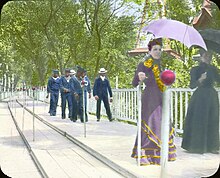Road of the Future (World Exhibition 1900)
The street of the future (French Rue de l'Avenir ) was a rolling footpath (French Trottoir roulant or Plateforme mobile , in German called step train ) 3.5 km in length, which was installed around the Paris exhibition grounds during the Paris World Exhibition of 1900 and had nine access stations.
Route and map
The Rolling Footpath followed the following path counterclockwise: Esplanade des Invalides , Quai d'Orsay ("Quai des Nations", along the Seine ), Champ de Mars (along avenue de La Bourdonnais ), avenue de La Motte-Picquet , Rue Fabert , only to return to the Esplanade des Invalides.
The Rue de l'Avenir needed 26 minutes for a round. The fare was 50 centimes . 14,000 people could be transported on it at the same time; on Easter Sunday afternoon (April 15) she transported 70,000 people. For comparison: at that time the busiest bus and tram lines were used by an average of 40,000 passengers a day.
A Decauville electric train followed the same route in the opposite direction. It was mostly at the same height as the Rolling Footpath , but sometimes also at ground level or even underground.
technology
The Rolling Footpath was originally designed by the American engineers Schmidt and Silsbee for the Chicago World's Fair in 1893 . In Paris, it was built on a 7 m high viaduct and consisted of one fixed and two movable moving walkways: the main moving walkway with a width of 2 m, which moved at a speed of 8 km / h, and the access walkway at half speed, which was only 80 cm wide.
The principle of the drive system, which is based on electric motors, can be understood from the drawing "Mechanism of the rolling footpath ". The electricity required to operate the system was supplied by the Moulineaux plant. The electricity supplied was converted into direct current, as this made it easier to start the system and allowed more flexible speed control. The current was conducted to the drives of the rolling footpath with 9 cables on a distribution box, from which the movement of the moving walks could be directed in one direction or the other and which enabled the entire system to be stopped immediately.
Others
The French film pioneer Georges Méliès made the films Panorama pris du trottoir roulant Champ de Mars (panorama taken from the Rolling Footpath on the Marsfeld) and Les Visiteurs sur le trottoir roulant (Visitors on the Rolling Footpath) on the street of the future .
literature
- The special means of transport of the Paris World Exhibition. Part III. The electric step train. In: Polytechnisches Journal . 315, 1900, pp. 605-610.
Web links
- The French WP original text is partly taken from the text Les trottoirs roulants de l'Exposition , from the magazine La Revue Scientifique , 4th series, Volume XIV, No. 21 of May 26, 1900 online in French
- Website 1900, exposition universelle et international de Paris (French)
Individual evidence
- ^ Cf. The Paris World Exhibition of 1900 (p. 7). Appendix to the 15th edition of Baedeker's Paris , Karl Baedeker, Leipzig 1900.




